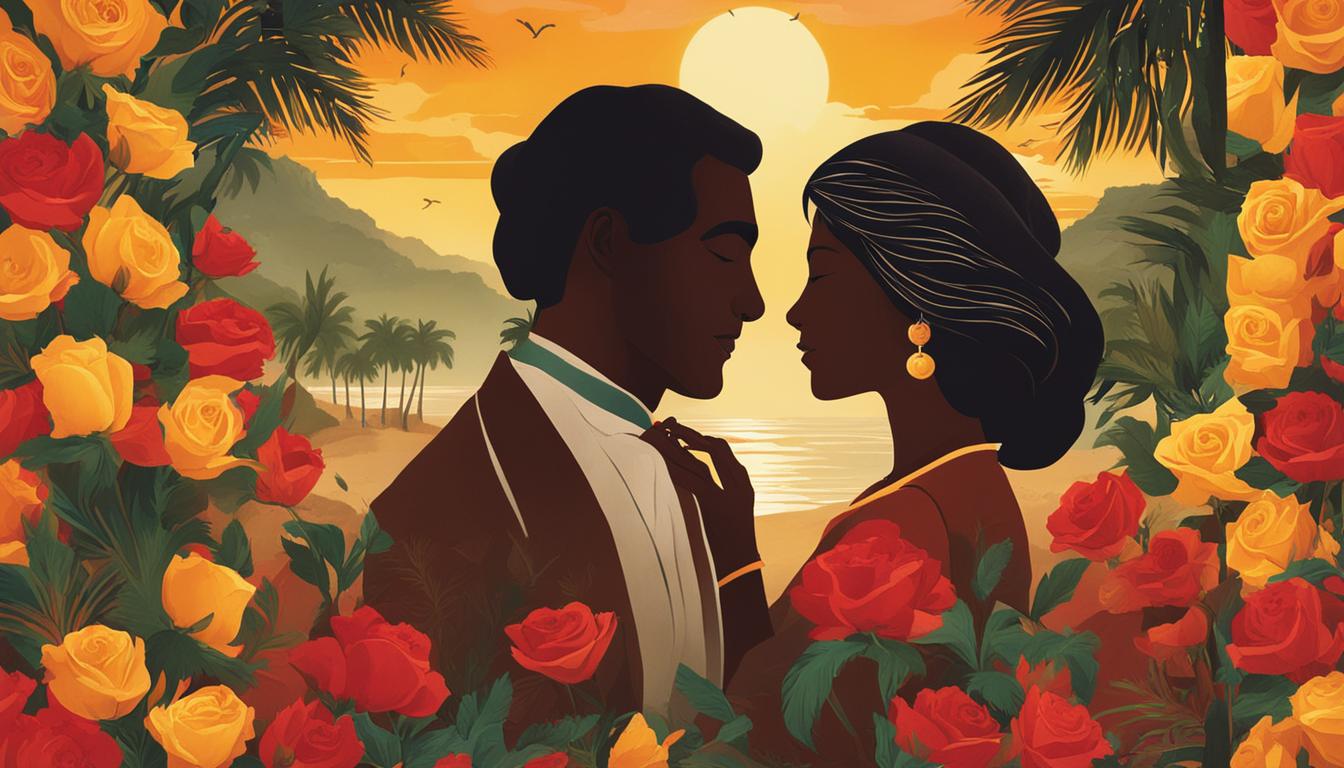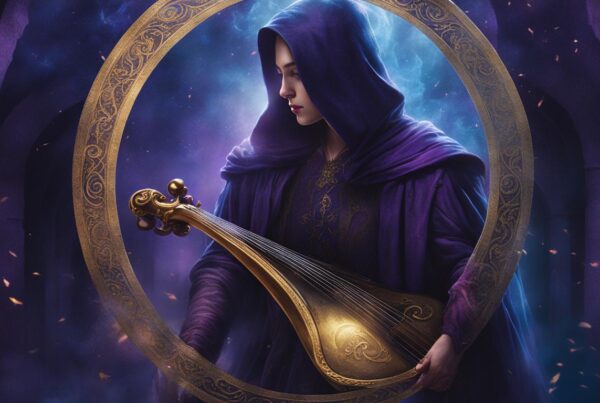The esteemed literary world reverberates with the name of Gabriel Garcia Marquez, a Nobel laureate whose romantic novel “Love in the Time of Cholera” continues to capture the hearts and imaginations of readers worldwide. This review will dive into the auditory journey of the novel’s audiobook adaptation, analyzing how its narrative nuances are elevated through the spoken word. As audiobook reviews become a cornerstone for prospective listeners, there’s an increasing curiosity about how these adaptations measure to the original prose.
With a legion of ardent fans and ongoing literary analysis, Marquez’s work manifests an enthralling tale of premium romantic novels in the audio format. Delve into our comprehensive review as we explore whether the intoxicating blend of love, longing, and the relentless passage of time retains its power in the embrace of modern auditory storytelling.
Introduction to Gabriel Garcia Marquez’s Masterpiece
The annals of Colombian literature are rich and diverse, but few writers have cast as long a shadow as Nobel laureate Gabriel Garcia Marquez. Renowned for his potent blend of magical realism and poignant narrative, Marquez’s oeuvre has left an indelible mark on the world of literary masterpieces. This section pays homage to his contribution to literature, particularly highlighting his iconic work, “Love in the Time of Cholera,” a classic that has become synonymous with Marquez’s legacy.
Gabriel Garcia Marquez’s journey in literature began in Aracataca, Colombia, and it was here that the seeds of magical realism were sown in fertile storytelling soil. His penchant for blending the fantastical with the mundane led to the birth of some of the most vivid and enduring tales of the 20th century, with “Love in the Time of Cholera” standing tall among them. The novel’s exploration of love, aging, and death resonates universally, speaking to readers far beyond its Colombian origins.
- What makes “Love in the Time of Cholera” a universally acknowledged gem in the crown of Gabriel Garcia Marquez classics is its deft narrative that weaves love’s resilience against the backdrop of a changing world.
- The allure of this novel lies not only in its thematic depths but also in the stylistic signature of Marquez, who infuses every page with enchanting magical realism and otherworldly beauty.
- Its passage through the ravages of time stands testament to its status among literary masterpieces, continuing to enamor critics and book lovers alike.
As we delve deeper into this review, prepare for an in-depth exploration of themes ranging from the invincibility of love to the relentless passage of time, from the novel’s unmistakable style to the immersive experience of its audiobook production. The following discourse aims to unravel the complex tapestry of “Love in the Time of Cholera,” its endurance as a narrative, and its position as a pivotal piece of literature that transcends the boundaries of imagination.
| Element | Contribution to Literature | Expression in “Love in the Time of Cholera” |
|---|---|---|
| Magical Realism | Elevates everyday occurrences to the realm of the fantastical | Infuses the love story with enchantment and wonder |
| Character Depth | Creates figures that are emblematic of human experience | Depicts the nuanced inner lives of Florentino Ariza and Fermina Daza |
| Social Commentary | Offers insights into cultural and historical contexts | Reflects on Colombian society during the turn of the 20th century |
It is the intricate melding of these facets that solidify “Love in the Time of Cholera” not only as a hallmark of Gabriel Garcia Marquez’s body of work but also as a timeless exploration of the human condition. Through the subsequent sections, we will traverse this rich landscape, charting the profound impact of Marquez’s classic upon the world of literature.
Setting the Scene: Historical and Cultural Context of the Novel
Immersing oneself in Gabriel Garcia Marquez’s “Love in the Time of Cholera” requires an understanding of its rich Colombian backdrop. The novel’s setting not only paints a vibrant picture of coastal Colombia but also encapsulates a profound historical context and a strong cultural influence. Marquez masterfully transports his readers to the late 19th and early 20th centuries, a period rife with political turmoil and societal transformation, ultimately shaping the Love in the Time of Cholera setting into a character of its own.
The Impact of Colombian Culture on the Story
Marquez’s narrative is deeply woven with the threads of Colombian culture, from the passionate rhythms of vallenato to the superstitions and myths that pebble the everyday life of his characters. The essence of Colombian identity is captured through vivid descriptions of everyday life, celebrating the syncretism of the nation’s diverse heritage. The detail with which Marquez depicts the social etiquettes, culinary traditions, and architectural beauty stands as a living homage to his Colombian roots, which lend the novel an air of authenticity and intimacy.
Understanding the Political Climate During the Time Period
The backdrop of “Love in the Time of Cholera” is not merely a picturesque tapestry but also a canvas depicting the scars and flowering of a nation through a turbulent historical epoch. Marquez sets his narrative against the backdrop of significant political events, such as the Thousand Days War and the ensuing US intervention that led to the secession of Panama. These events not only influenced the fates of the characters but also the ebb and flow of Colombian society. It is within this charged political climate that the characters of Florentino Ariza and Fermina Daza find love, loss, and solace.
| Cultural Element | Description | Impact on Narrative |
|---|---|---|
| Music (Vallenato) | Traditional Colombian music genre known for its storytelling in verse. | Reflects the emotional landscape of the characters and the rhythm of Caribbean life. |
| Architecture | Colonial and Antillean styles that mark the economic status and identity of characters. | Sheds light on the social stratification and historical transformation of Colombian cities. |
| Political Unrest | The narrative is set around historical events like the Thousand Days War. | Shapes the character’s destinies and mirrors the societal shifts affecting individuals. |
Character Analysis: The Protagonists’ Journey Through Love and Sickness
The intricate tapestry of Garcia Marquez protagonists is beautifully illustrated through the evolving emotional landscapes of Florentino Ariza and Fermina Daza. Their character development is central to the heart-wrenching love stories that unfold within the storied pages of Gabriel Garcia Marquez’s novels. This section delves into how these beloved literary characters mirror the duality of love’s warmth and sickness’s shadow, revealing the novel’s profound themes.

Fermina and Florentino’s journey is not one of simple affections but a complex voyage marked by personal growth, societal pressures, and existential reflection. Their story is a poignant exploration of the human soul with its capacity for both enduring fidelity and profound solitude. Below is a closer look at the protagonists’ traits at critical junctures in their lives.
| Character | Early Development | Maturity | Love and Sickness |
|---|---|---|---|
| Florentino Ariza | Hopelessly Romantic Idealist | Wistful and Tenacious | Embodies the Persistence of Love |
| Fermina Daza | Rebellious and Bold | Practical and Resolute | Reflects the Ailment of Heartache |
As the narrative unfolds, it becomes clear that the choices made by Florentino and Fermina do more than drive the plot forward—they encapsulate the essence of Garcia Marquez’s exploration of love as both a redeeming and destructive force. Their decisions underscore the transformative power of love and its ability to eclipse the boundaries of time, health, and social convention.
“It was inevitable: the scent of bitter almonds always reminded him of the fate of unrequited love.”
This quote encapsulates the bittersweet essence of the romantic pursuit and the lengths to which these characters will go to experience love in its fullest form. Garcia Marquez’s ability to weave this eternal dance of love and sickness into the lives of his characters is nothing short of literary mastery.
The Narrative Style of Magical Realism
Gabriel Garcia Marquez’s style of weaving magical realism into the fabric of his narratives has captivated readers and placed his work at the pinnacle of world literature. His novels, such as “Love in the Time of Cholera,” showcase this literary technique with such finesse that the lines between the magical and the real blur beautifully.
Defining Magical Realism and Its Significance in Literature
At its core, magical realism is a narrative technique where the supernatural is presented as mundane. Garcia Marquez, recognized as one of the style’s masters, uses this approach to highlight the extraordinary within the ordinary. His deft application of magical realism is not merely for the sake of fantasy but serves as a lens through which one can explore complex human emotions and socio-political realities.
How Magical Realism Influences the Reader’s Experience
Through the fusion of real-world settings and fantastical elements, magical realism in literature offers readers an enriched experience. Garcia Marquez’s style prompts a deeper literary analysis, where one is encouraged to uncover layers of meaning hidden within the surreal. This technique deeply affects how stories are perceived, transforming readers’ understanding of the narrative and characters.
| Characteristic | Influence on Storytelling |
|---|---|
| Integration of the Extraordinary | Enhances the narrative’s depth and offers a unique perspective on reality. |
| Subtle Distortion of Time | Alters the reader’s perception of chronology, emphasizing a timeless quality in the tale. |
| Use of Vivid Imagery | Creates an immersive world where readers visualize the fantastic as tangible. |
| Plausible Impossibilities | Challenges readers to accept the implausible, engendering a sense of wonder and contemplation. |
Magical realism remains a hallmark of Garcia Marquez’s legacy, mirroring the intricacies of the human condition and expanding the horizons of narrative techniques. The author’s adept blend of the marvelous with the mundane invites not just ephemeral escapism but also a robust engagement with the narrative’s deeper truths.
Themes of Love and Obsession in “Love in the Time of Cholera”
In Gabriel Garcia Marquez’s “Love in the Time of Cholera,” love and its many forms serve as the narrative’s backbone, while obsession acts as a haunting melody that weaves through the tapestry of the story. Across decades, readers have explored these recurring love themes, examining how they intersect with the human condition. Marquez expertly portrays these experiences with literary obsession and romantic obsession, making it a touchstone for discussions about themes in literature.
The Different Facets of Love Portrayed in the Novel
The novel unfolds varying shades of love, ranging from the impetuous, impulsive affections of youth to the deep, abiding connection that only years of life can cultivate. Young love, replete with idealism and passion, is depicted with such raw intensity that it remains poignant in the psyche of readers. As characters age, mature love takes shape, seasoned with experience and marked by sacrifice, showing a stark contrast. These love themes mirror life’s own evolution, making the novel an enduring mirror of reality.
Obsession as a Central Theme and Its Representation
Oftentimes, love in Marquez’s world slips into the realm of obsession, blurring the lines of decency and desire. Literary obsession is not only a powerful narrative force but also a character trait that defines the protagonists’ lives. Romantic obsession, a key element driving the plot, is characterized by unyielding adherence to the belief in a destined love, regardless of societal norms and personal well-being. It is this blend of love and obsession that deeply resonates with audiences, highlighting the complexities and the universal truths of human desires.
“The heart’s memory eliminates the bad and magnifies the good, and that thanks to this artifice we manage to endure the burden of the past.”
This reflection in Marquez’s language encapsulates the intricate dance between love and memory, tying it intrinsically to how characters metabolize their obsessions.
- Portrayals of YOUTHFUL INFATUATION and its transformative power.
- Depictions of MATURE COMPANIONSHIP, highlighting love’s evolution over time.
- OBSERVATIONS on the human propensity towards OBSESSION in love’s pursuit.
- ANALYSIS of love’s IMPACT on character development and storytelling.
Marquez’s tale persists in its exploration of love and obsession, motifs firmly rooted in human experience. His depiction of these themes continues to inspire and provoke readers, securing “Love in the Time of Cholera” as a pivotal study in literary expressions of the most passionate of human emotions.
Symbolism and Metaphors: Unlocking Deeper Meanings in the Text
The use of literary symbolism and metaphorical writing is a hallmark of Gabriel Garcia Marquez’s narrative prowess. In “Love in the Time of Cholera”, these literary motifs are not just decorative elements, but core components that enhance the storyline, providing readers with a richer understanding of its themes. One might say Garcia Marquez’s symbolism serves as a hidden language, waiting to be decoded by the reader.
For instance, the ubiquitous presence of water as a symbol throughout the novel represents the flow of time and the fluidity of love. It captures the essence of change and the character’s journey through life. Moreover, the use of flowers, especially in the context of Florentino Ariza’s tokens of affection, symbolizes the fleeting nature of beauty and the passion that can either bloom fervently or wither away with neglect.
“…the river that reminded them of their love was coming to an end. But it was also a time of prosperity for their invincible love. They had lived together long enough to know that love was always love, anytime and anyplace, but it was more solid the closer it came to death.” – Gabriel Garcia Marquez, “Love in the Time of Cholera”
Through his adept use of Garcia Marquez symbolism, the author weaves a tapestry that explores themes such as mortality, the struggles of society, and the enduring nature of love. These literary devices are subtly layered within the narrative, prompting readers to explore deeper than the surface-level plot to unpack the novel’s true meanings.

- Cholera: Not only a disease but also a metaphor for both the destructive and curative powers of love.
- The River: A symbol of life’s continuum as well as the separations and reunions that characterize love.
- The Parrot: Represents the mimicry of society’s appearance versus its underlying reality.
| Symbol | Representation |
|---|---|
| Water | Change, love’s eternal flow, life and death |
| Flowers | Beauty, passion, ephemerality of life |
| Letters | Communication, longing, the passage of time |
Critical Reception and Legacy of the Novel
The enduring power of Gabriel Garcia Marquez’s “Love in the Time of Cholera” is evidenced not only by its unwavering literary acclaim but also by its profound modern literature impact. Since its publication, the novel has received continuous praise and stands today as one of the award-winning novels defining Garcia Marquez’s career and the broader literary landscape. This section examines how the novel is still relevant to today’s readers and how it has influenced contemporary writers and the Gabriel Garcia Marquez legacy.
How “Love in the Time of Cholera” Resonates with Modern Readers
In an era where the literary world is constantly evolving, the timelessness of “Love in the Time of Cholera” stands as a testament to Gabriel Garcia Marquez’s storytelling prowess. Its themes of enduring love and the complexities of human emotion continue to captivate and resonate with a 21st-century audience, securing its place in the canon of novels that transcend time.
The Influence of the Novel on Contemporary Writers
Garcia Marquez’s masterful blend of magical realism and intricate narrative has had a significant influence on a host of contemporary writers. The innovative techniques he employed and the universal truths he explored in his writing have become a rich source of inspiration for authors looking to push the boundaries of storytelling in their works. “Love in the Time of Cholera” serves as a benchmark for literary excellence and originality in narrative craft.
| Aspect | Impact on Modern Literature | Influence on Contemporary Writers |
|---|---|---|
| Storytelling Techniques | Set new standards for narrative structure and character development | Encouraged experimentation with non-linear timelines and deep psychological portrayal |
| Magical Realism | Elevated genre to global prominence, blending the fantastic with the mundane | Popularized the use of magical elements as a means to express socio-political commentary |
| Themes of Love and Time | Challenged contemporary perceptions, illuminating love’s sustainability across demographics | Inspired nuanced explorations of love in its various forms and complexities |
An Audiobook Review of “Love in the Time of Cholera”
As we delve into the auditory world of Gabriel Garcia Marquez’s timeless romance, “Love in the Time of Cholera,” it becomes apparent that the essence of this beloved novel can be significantly influenced by the medium through which it is experienced. Audiobook narration and audio adaptations have offered a new platform for literature enthusiasts to immerse themselves in the world of Florentino Ariza and Fermina Daza, bringing forth an innovative, immersive audiobook experience.
The Effectiveness of Narration in Conveying the Novel’s Essence
The role of narrators in literature is pivotal, and the audiobook of “Love in the Time of Cholera” is no exception. Narrators provide not just a voice to the characters, but also set the tone for the narrative, creating an intimate bridge between the text and the listener. An examination of this audiobook’s narration reveals a meticulous interpretation that captures the emotional depth and lyrical beauty inherent in Marquez’s prose. The subtleties in pacing, tone, and expression by the narrator play a crucial role in connecting listeners to the novel’s rich, evocative landscapes, and its complex character dynamics.
Enhancing the Experience: Music and Sound Effects in the Audiobook
When examining the production qualities, we notice that music and sound effects are employed throughout the audiobook to enhance the storytelling atmosphere. These elements can transport the listener, evoking the ambiance of early 20th-century Colombia, and amplifying key moments with an added layer of emotional resonance. However, it prompts a deeper inquiry into whether these additional sounds support or intrude upon the listener’s engagement with the story. Our review reveals a careful balance, as the music and soundscapes never overshadow the narrative itself, but rather complement the highs and lows of this passionate love story.
In conclusion, the audiobook adaptation of “Love in the Time of Cholera” serves as a testament to how contemporary audio adaptations can offer fresh and immersive avenues for experiencing classic literature. The skilled blend of narration and auditory enhancements can indeed introduce an additional dimension to the novel, preserving its original essence while creating a captivating experience for new and returning admirers of Marquez’s work.
Conclusion
In the intricate tapestry of romantic literature, “Love in the Time of Cholera” by Gabriel Garcia Marquez stands as a testament to the power of enduring love and the finesse of magical realism. This literary analysis has journeyed through the majestic narrative and its illustrious adaptation into the audiobook medium, not only tracing the thematic and stylistic nuances but also exploring the emotive resonance made possible through exemplary narration.
Reflecting on the Enduring Impact of “Love in the Time of Cholera”
As we delve into the conclusion of literary analysis, it is compelling to witness how “Love in the Time of Cholera” has secured a steadfast position in the realm of timeless literature. Marquez’s romantic legacy is embroidered in the very fabric of his narrative—each thread a fine blend of love’s myriad manifestations with the textual magic that colours every page. The novel’s ingrained cultural significance and unfading themes, brought anew to life in its audiobook form, secure its place among enduring novels that continue to captivate the hearts of readers globally.
Final Thoughts on Gabriel Garcia Marquez’s Timeless Romance
Summoning the essence of Garcia Marquez’s visionary work, this review reaffirms the novel’s indelible imprint on the landscape of literary history. From an immersive plunge into the throes of passion, obsession, and the complexities of human connection, to the splendid portrayal of a bygone era wrapped in the auditory enchantment of the audiobook, “Love in the Time of Cholera” remarkably endures. It remains not just a cornerstone of literary excellence, but also a beacon that chronicles the inextricable links between love, life, and the everlasting human spirit. In essence, Marquez’s masterpiece is a profound dialogue that continues, enduring as ever, with each new generation of readers.



